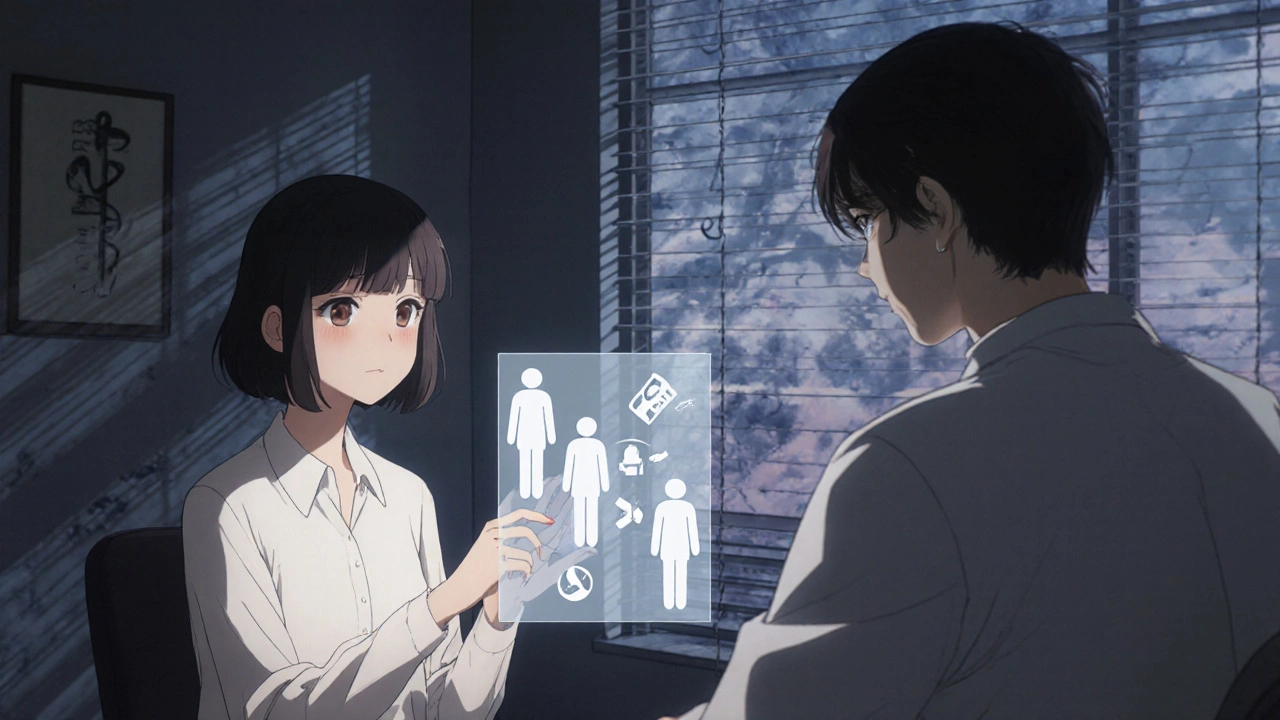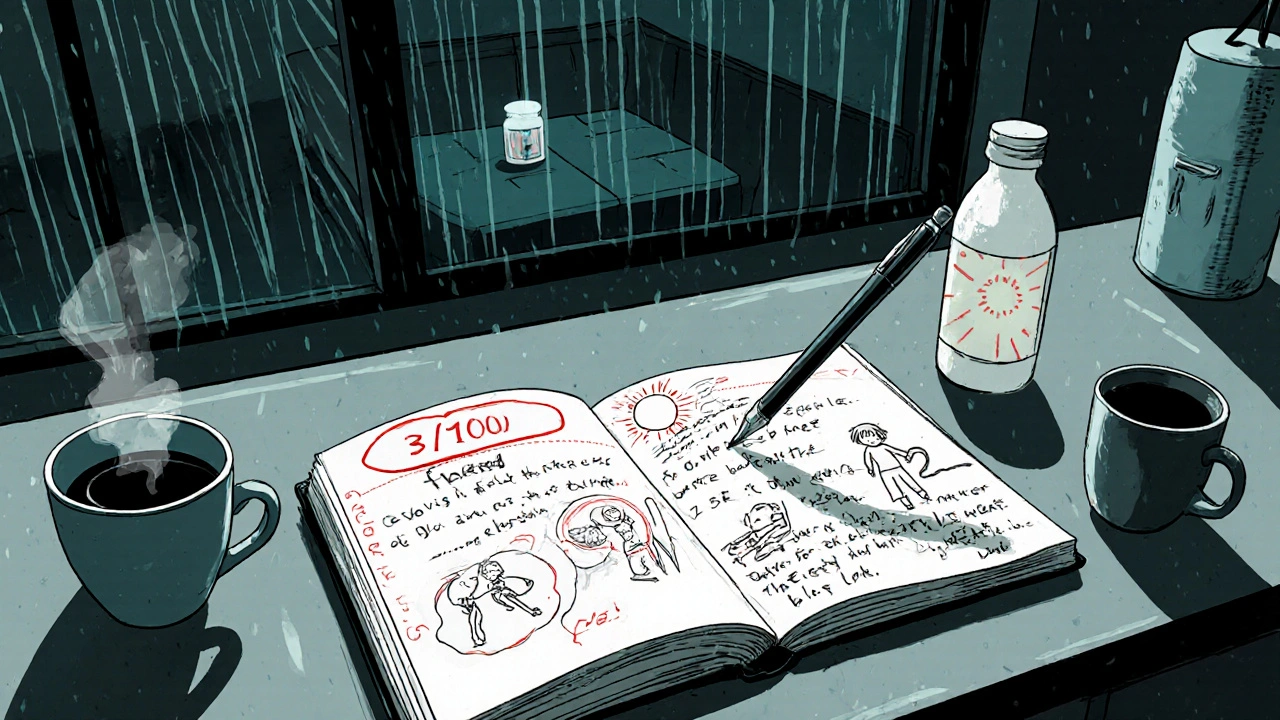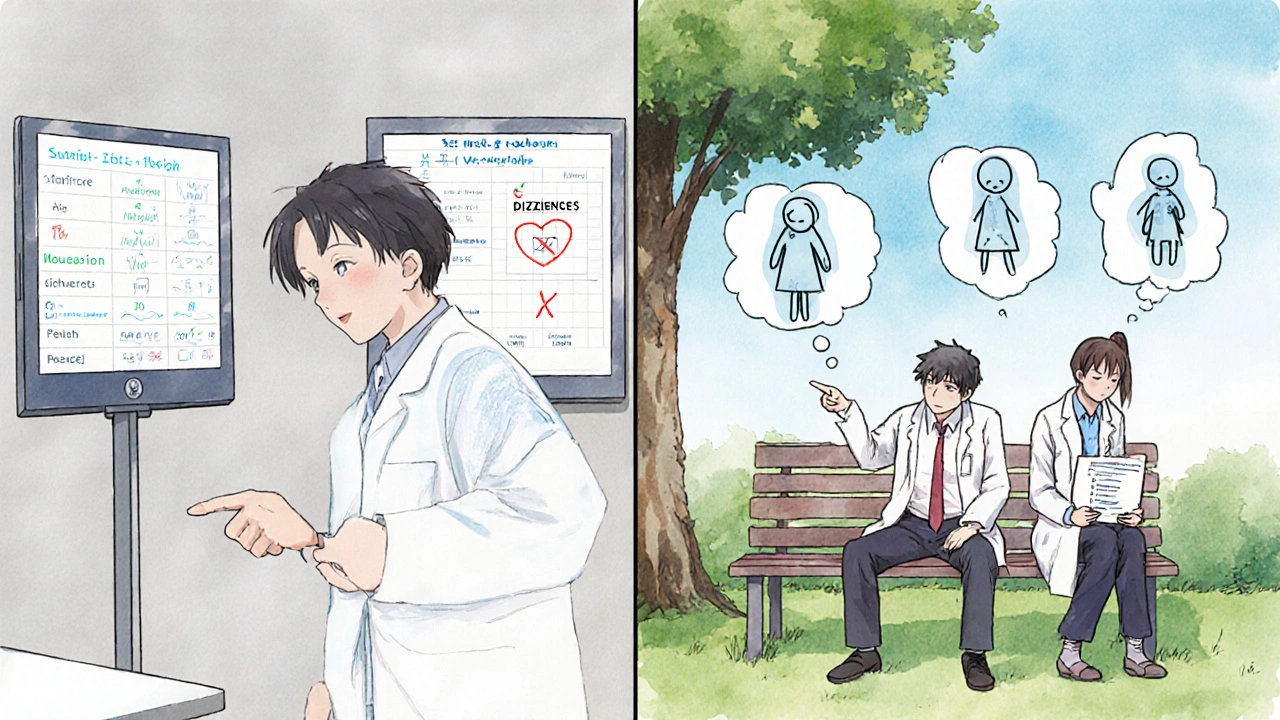Shared Decision-Making Scripts for Side Effect Trade-Offs in Medication Choices
 Nov, 19 2025
Nov, 19 2025
Side Effect Trade-Off Calculator
How important are these side effects to you?
This tool helps you identify which side effects would most impact your daily life. Answer the questions below to see which side effects could be deal-breakers for you.
Rate from 1 (least impact) to 5 (most impact)
5 = prevents daily activities
5 = unable to work or care for yourself
5 = prevents walking or driving
5 = affects self-esteem and health
5 = prevents exercise or daily tasks
5 = affects drinking or eating
When you’re prescribed a new medication, you’re often told about the benefits-but what about the side effects? Not just the list you read in the pamphlet, but the real ones that could change your daily life: nausea that keeps you from work, fatigue that steals your evenings, or dizziness that makes you afraid to walk the dog. Many patients stop taking their meds not because they don’t believe in them, but because they weren’t truly heard. That’s where shared decision-making comes in-not as a buzzword, but as a practical, structured way to talk through what matters most to you.
Why Side Effect Trade-Offs Are Hard to Talk About
Most doctors mean well. They’ll say, "This drug reduces your stroke risk by 30%." But what does that actually mean for you? If your chance of a stroke was 5% without the drug, a 30% reduction brings it down to 3.5%. That’s a real benefit. But if the drug causes nausea in 1 in 4 people, and you’ve already struggled with stomach issues, that’s not just a statistic-it’s your reality. The problem isn’t the doctor’s intent. It’s the gap between clinical data and lived experience. Research from the Massachusetts General Hospital Health Decision Sciences Center shows that 42% of patients who regret their medication choices do so because they didn’t fully understand how treatment would affect their daily life. That’s not just about side effects-it’s about burden. Can you still play with your kids after taking your pill? Will you need to nap every afternoon? Will you be too dizzy to drive? These aren’t minor concerns. They’re the reason people stop taking statins, anticoagulants, and even antidepressants.The SHARE Approach: A Simple Framework for Tough Conversations
The Agency for Healthcare Research and Quality (AHRQ) developed the SHARE Approach as a clear, five-step way to guide these conversations. It’s not about memorizing scripts-it’s about creating space for real dialogue.- Seek opportunities to involve you in the decision. Instead of saying, "I’m prescribing this," a clinician might say, "There are a few options here. Which one feels right for your life?"
- Help you explore the choices. This means comparing side effects side-by-side. For example: "Medication A has a 15% chance of dizziness but only 5% for weight gain. Medication B has a 25% chance of nausea but only 8% for dizziness. Which is harder for you to live with?"
- Assess your values. This is where the magic happens. Instead of asking, "Do you have concerns?" they ask, "What side effect would make you say no to this drug?" That single question shifts the entire conversation.
- Reach a decision together. No one leaves the room feeling talked at. The choice is clear: "So we’re going with Medication B because you’re okay with nausea but not dizziness. We’ll check in in two weeks to see how you’re doing."
- Evaluate the decision later. Did the side effects match what you expected? Did your life improve? If not, you’re not failing-you’re giving feedback that helps adjust your plan.
This isn’t theory. A 2021 study in JAMA Internal Medicine found that patients using this approach were 29% less likely to quit their meds because of unexpected side effects. That’s not just better adherence-it’s fewer hospital visits, fewer panic calls, and more trust.
The Three-Talk Model: When Numbers Matter More Than Words
Vague terms like "rare" or "common" are dangerous. One person’s "rare" is another person’s "I know someone who had it." The Three-Talk Model fixes this by using absolute risk numbers-clear, simple, and hard to misinterpret. Instead of saying, "There’s a small risk of bleeding," say: "Out of 100 people who take this drug, 3 will have a major bleeding event in a year. That means 97 won’t." That’s a difference you can picture. Research in the Annals of Internal Medicine shows patients understand risk 37% better when it’s presented this way. Clinicians using this model also avoid framing side effects as "avoidable" or "unavoidable." Instead, they say: "This side effect is possible, and here’s how likely it is. You get to decide if that’s acceptable." That’s not just honesty-it’s respect.
What Patients Really Say
On Reddit’s r/medicine, one user wrote: "My doctor didn’t just tell me about the side effects. He asked me which ones I’d tolerate and which would ruin my life. I cried. Not because I was scared-but because someone finally asked me what I cared about." That post got over 140 upvotes. Why? Because it’s rare. A 2022 survey by the Informed Medical Decisions Foundation found that 84% of patients felt more confident in their choice when their doctor used structured tools to discuss side effects. But here’s the flip side: 63% of patients said they felt frustrated when doctors just "read from a script" without listening. The difference? Personalization. A script is a tool, not a script. One patient advocate on HealthUnlocked put it simply: "Ask me which side effect would be a deal-breaker. That’s the only question I need to hear."Why This Works Best for Chronic Conditions
Shared decision-making isn’t for every situation. In an emergency, there’s no time. But for long-term meds-statins, blood thinners, antidepressants, diabetes drugs-it’s essential. Take statins. Eighty-six percent of people who stop taking them say it’s because of side effects like muscle pain or fatigue. But if you’ve had a heart attack, the benefit is huge. The key isn’t to push the drug-it’s to match it to your life. One patient told me, "I didn’t want to feel like a zombie. My doctor said, 'Let’s try the lowest dose and see how you feel.' That’s the only reason I’m still on it two years later." The same goes for anticoagulants. A 3-5% annual risk of major bleeding sounds scary. But if you’re 70 and active, and your risk of stroke without the drug is 8%, you might decide the trade-off is worth it. Or you might not. That’s your call.Barriers and How to Overcome Them
Time is the biggest hurdle. A 2022 study at Scripps Health found that doing a full shared decision-making session adds about 7.3 minutes to a visit. That sounds like a lot-until you realize it cuts follow-up visits by 22%. Fewer calls about side effects. Fewer refill requests. Fewer patients quitting meds because they felt unheard. Many doctors feel untrained. The American Academy of Family Physicians reports that 72% of primary care physicians say they don’t have enough time to do this well. But training helps. MGH’s 4-hour program, which includes role-playing tough conversations, has helped clinicians get better in just 12 supervised sessions. The solution? Pre-visit tools. Videos, apps, or printed sheets that explain side effect risks before you even walk in. Kaiser Permanente reduced statin discontinuation by 33% by sending patients a short video explaining side effect probabilities before their appointment. That cuts the in-office conversation time by over 3 minutes-and makes the talk more meaningful.
What’s Changing Now
The healthcare system is catching up. In 2023, Medicare Advantage plans were required to document shared decision-making for high-risk medications. That’s driving real change. Epic Systems, the biggest electronic health record provider, now includes SDM modules in 63% of U.S. hospitals. These aren’t just checklists-they’re condition-specific prompts: "For statins, ask: What side effect would make you stop?" And there’s reimbursement now. The AMA created CPT codes 96170-96171 in 2022 that pay doctors $45-$65 for documented shared decision-making visits. That means it’s no longer seen as "extra work"-it’s part of care. Even AI is getting involved. The NIH funded a $2.3 million project in 2023 to build tools that listen to patient-clinician conversations and flag unspoken concerns-like when someone says, "I guess I can live with it," but their tone says otherwise.What You Can Do Today
You don’t need a perfect system to start. Here’s what you can ask next time you’re prescribed a new medication:- "What’s the chance I’ll actually get this side effect?" (Ask for a number, not "rare" or "common")
- "Which side effect would make you say no to this drug?"
- "How will this affect my daily life-sleep, energy, work, family time?"
- "What if I don’t take it? What happens then?"
- "Can we try the lowest dose first and adjust if needed?"
These aren’t just questions. They’re invitations-to be heard, to be respected, to be part of your own care.
Final Thought: It’s Not About Perfect Decisions. It’s About Right Ones.
There’s no "best" drug. There’s only the right drug for you-right now. And that’s not something a doctor can decide alone. Shared decision-making isn’t about giving you more choices. It’s about helping you choose the one that fits your life.Side effects aren’t just medical facts. They’re life-altering experiences. And when your doctor takes the time to understand what matters to you-your sleep, your job, your peace of mind-that’s not just good medicine. It’s human medicine.
What exactly is shared decision-making in healthcare?
Shared decision-making is a process where you and your clinician work together to choose a treatment based on your medical options, your personal values, and what matters most in your daily life. It’s not about the doctor deciding for you or just giving you a list of risks. It’s a conversation that balances evidence with your experience.
Why are side effect trade-offs so hard to talk about?
Because side effects aren’t just numbers-they’re real disruptions to your life. A 15% chance of nausea might sound low, but if you’re a parent who needs to be alert for your kids, that’s a big deal. Doctors often focus on clinical benefits, while patients worry about daily impact. Without direct questions, those concerns go unspoken.
What’s the difference between relative and absolute risk?
Relative risk sounds bigger. For example, "This drug cuts your risk of stroke by 50%"-but if your original risk was only 2%, a 50% cut means it’s now 1%. Absolute risk tells you the real number: "Your chance of stroke drops from 2% to 1%." Absolute numbers help you understand what it actually means for you, not just how impressive the stat sounds.
Can shared decision-making be done in a 10-minute appointment?
Yes, but it needs preparation. If you’ve reviewed side effect info before your visit, the conversation can be focused and quick. The key isn’t length-it’s clarity. One well-placed question like, "What side effect would make you say no?" can do more than ten minutes of generic advice.
Do I need to use a decision aid or app?
Not necessarily, but they help. Tools like printed charts, videos, or online modules can show you side effect probabilities visually. Studies show patients understand risks better with color-coded charts. But even without tech, asking the right questions gets you 80% of the way there.
What if my doctor doesn’t want to do shared decision-making?
You can still lead the conversation. Say: "I’d really like to understand how this medication might affect my day-to-day life. Can we talk about the side effects that matter most to me?" Most doctors will respond if you’re clear about what you need. If they resist, it’s okay to ask for a second opinion or seek a provider trained in patient-centered care.

Joe bailey
November 19, 2025 AT 04:25This is the kind of post that makes me believe healthcare can actually get better. I’ve been on statins for five years and my doc never asked me which side effect would ruin my life-until I finally said it myself: 'I can’t nap all afternoon and still pick up my kid from school.' He switched me to a lower dose and now I’m actually living, not just surviving. We need more of this, not less.
Amanda Wong
November 20, 2025 AT 18:28Let’s be real-this whole 'shared decision-making' thing is just corporate healthcare’s way of shifting blame. You think your doctor doesn’t know you’re going to quit the meds? Of course they do. They’re just paid to push pills, not have 'conversations.' The real problem? Insurance won’t cover the time it takes to actually listen. So now we’re pretending empathy is a protocol. Cute.
Stephen Adeyanju
November 22, 2025 AT 04:34I had a doctor tell me my anticoagulant had a 3 in 100 chance of bleeding and I said okay and then I bled and now I’m here and I’m mad and I don’t care about your percentages because I’m the one who had to clean up the blood on my bathroom floor and no one asked me if that was worth it
james thomas
November 23, 2025 AT 17:08Of course they’re pushing this SHARE nonsense now that Medicare’s paying for it. This isn’t patient care-it’s billing optimization. The same people who rushed you out the door in 7 minutes last year are now doing 'structured dialogues' because they get $65 extra. Don’t be fooled. They don’t care about your sleep schedule. They care about their CPT codes. And AI listening to your tone? That’s just the next step toward insurance companies deciding if your suffering is 'valid' enough to justify your meds.
Deborah Williams
November 25, 2025 AT 02:47How poetic that we’ve turned human vulnerability into a checklist. We’ve reduced the terrifying, intimate act of choosing whether to risk nausea, fatigue, or bleeding to a five-step framework with bullet points and CPT codes. We call it 'empowerment' when it’s really just packaging despair in a pretty slide deck. The fact that patients cry when someone finally asks 'what would ruin your life?' isn’t a win-it’s a funeral. And we’re all just showing up with flowers and a clipboard.